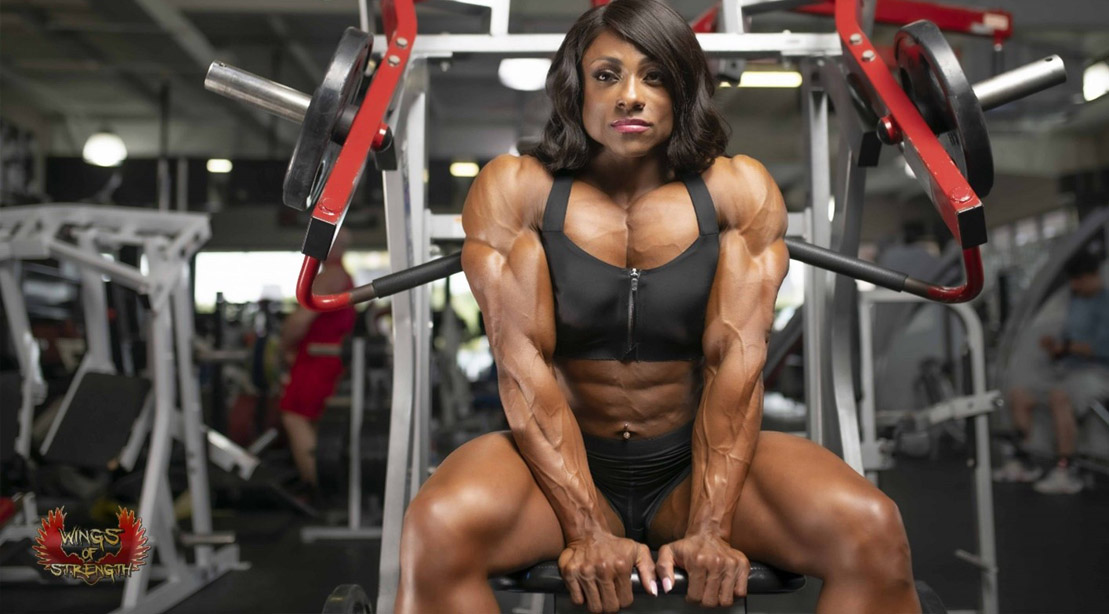Ms. Olympia Andrea Shaw
In other words, PROGRESSIVE RESISTANCE TRAINING.
The same has been true of Andrea. “I want to build as much solid muscle mass as I can,” she told me. “And that means working with heavy weight all the time. But I want shapely muscle, not the kind of slab muscle you see with a powerlifter. So, I have always kept the reps high.”
Where most bodybuilders are staying in the 6 to 12-rep range, Andrea keeps going. “My goal is 20 reps sets with heavy weight. But I never settle for fewer than 12 to 15 reps at minimum.”
As a result of this intense effort, Andrea has ended up being much bigger than seems apparent at first. But she is so symmetrical and aesthetic, fans are often surprised that she competes at about 180 pounds. Consider that Lenda Murray, with whom Andrea is often compared, was at her best on stage at something like 145 pounds. That is 35 pounds muscle difference!
Another significant thing about Andrea Shaw’s training is how many days she works out. One major difference between bodybuilding nowadays and some thirty years ago is that successful competitors tend to train less and rest and recuperate more than they used to. But that is not the case with Andrea. Until recently, she trained seven days a week. And even though she has cut back on this schedule recently, she is still in the gym six days a week.
“I started out with a more conventional approach to training,” she says. “It was only after many years of working out that I developed my individual approach. It took a long time for me to learn my body. I may very well make changes to my routine in the future. I will go by how I feel and what progress I am making.”
Andrea cautions others to not copy her training approach but to start out with a more conventional approach and gradually make any changes your body seems best to respond to. Both she and Ronnie Coleman are exceptionally strong by nature. But there have been great champions who took very different approaches with success – training lighter, for example, and with styles ranging from HIT to super-high volume.
Andrea Shaw, unlike almost everyone else in the sport, has been on a consistent 7 day a week training cycle. Quite recently, she cut back to 6 days a week workout. But following is how she approached her workouts for her Ms. Olympia victories.
Another remarkable aspect of Andre Shaw’s training is that she may have the best arms in the history of bodybuilding for women. BUT SHE DOESN’T TRAIN ARMS. That is, she doesn’t do specific workouts for the biceps and triceps but depends on her heavy pushing exercises (for chest and shoulders) to build triceps and pulling movements (back) for her biceps.
I am reminded that the top champions in any sport are usually genetic geniuses. For example, I have done forearm training articles where it turned out the bodybuilders with the best forearms didn’t actually train them at all. This is another one of those “nature” factors.
Some bodybuilders are simply gifted with the ability to build calves, abs, or forearms. I once did a calf training article on a bodybuilder who developed great calves doing nothing more than calf raises leaning against a wall. I did a back training video with Lenda Murray, who had a great back, where I had to correct her technique in many movements because what she was doing worked for her because she was genetically gifted but would probably not work for most viewers of the video.
On the other hand, Arnold always built great biceps with no problem but had to work very hard to pump up his triceps to match before each contest. He had the genetics for triceps, they just needed a lot of extra work to catch up. Arnold recognized which body parts needed extra work and organized his training accordingly. Genetics are always a factor to be considered. If you don’t believe in the limitations of genetics, then get taller.
So, for would-be champion bodybuilders, what should be emulated is Andrea’s work ethic in the gym rather than her specific workouts. She is in and out in an hour, doing 5 to 6 exercises, but that hour is devoted to intense, unrelenting work. She blasts out her sets with maximum intensity and moves from one set and exercise to another with minimum pauses in between. Again, she explains this level of intensity is not something you should expect to achieve right off the bat. Like working with heavy weight, you need to work up to it over time. Everything is “progressive.”
And it also takes time to come close to your potential when it comes to developing a muscular, aesthetic physique.
Andrea Shaw remembers what it was like when she was first starting out. A gymnast and a cheerleader, at the age of 18, Andrea’s training adviser told her mom she didn’t think Andrea had the heart to stick with training. This encouraged her to focus on working hard to get into great shape. While training one day at Powerhouse Gym in Detroit, she came across a copy of Oxygen Magazine and saw the magazine was full of athletic fitness and sports models. She decided that creating that kind of fit and shapely physique would be her ambition. However, her body began responding quickly to resistance training and once she started intense weight training, soon people were asking her if she competed in muscle competitions. She didn’t see herself as having enough size and development to compete as a bodybuilder but liked the way the figure competitors looked in the magazines.
In 2008, she entered two figure competitions, placing 3rd and 4th, but she didn’t feel she was on the right path. At this point, Andrea took eight years off from competition, getting a college degree for one thing, but continuing to train hard all that time. “That period was critical to my success,” she explains. “It takes some 10 years or more for most bodybuilders to evolve to the pro level – men and women both. In the early days of women’s bodybuilding, women would often compete after only two or three years of serious training. Not only did they not achieve anything like their potential at that point, interrupting your development by dieting for competition slows you down even more.”
That is why, she points out, we didn’t see a lot of pro women bodybuilders with really impressive muscle mass and development until the 1990s. It took that long for most potential champions to develop and mature. In her own case, Andrea credits her eight-year pause to the degree of development she has managed to achieve. “During that time, I just trained hard. I didn’t compete so I didn’t have to do a contest diet. That means there was nothing to interfere and slow down how my body developed.”
So along with advising would-be champions to train with maximum intensity, Andrea Shaw also tells them to be patient, give themselves time to build quality muscle, and not be too quick and eager to enter competition. And when they do, she says, don’t compete too often. Certainly, not two or three times a year, as some do.
“You can’t really peak that often,” she advises. “And when you try, it means you are slowing down your path to ultimate genetic potential. You can’t really grow when you are on a severe diet all the time.”
“Train hard,” she says, “train smart and let your body develop at its own pace”. For some, this will be faster and sooner than others. It depends on individual genetics. As the old commercial says, YOU CAN’T FOOL MOTHER NATURE.




